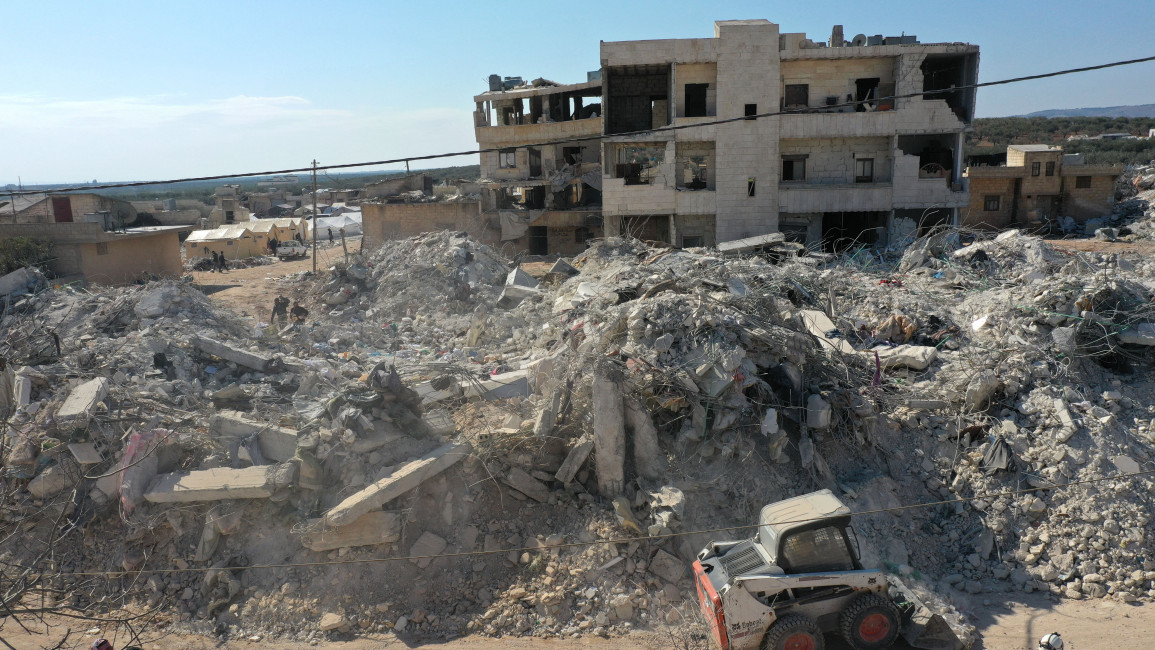Syrian aid workers say not enough heavy equipment, machinery to save quake survivors
Rescue workers in northern Syria have been severely limited in their efforts due to a lack of resources and a slow international humanitarian response to the 7.8 magnitude earthquake that devastated the region, according to aid groups who spoke to The New Arab.
Syrian rescue workers need more equipment and heavy machinery to save as many people as possible in search operations following the Turkey-Syria quake, founding member of NGO Molham Atef Nanoua told The New Arab.
Turkish relief groups have also complained of a lack of equipment and expertise to save those still trapped.
As of February 16, over 6,000 deaths were reported from Syria following the earthquake, with these numbers likely proving un-representative and many still being stuck under the rubble, according to the UN.
The UN OCHR have cited civil defence partners as saying only five percent of reported sites in need of search and rescue operations can be covered in northwest Syria – where the majority of Syrian casualties occurred.
“The situation is a disaster… it can’t be described through videos or pictures… we are trying to help as many people as possible… but there are not enough resources… thousands of people are under the rubble because of a lack of equipment,” Atef Nanoua said.
The most urgent needs in the north-west of the region include heavy machines for debris removal and tents for victims of the quake who have become displaced, according to the OCHR, as “the lack of heavy machinery to remove rubble… complicate these [rescue efforts] significantly” NW.
Urban Search And Rescue (USAR) operations – dealt with by the UN’s International Search and Rescue Advisory Group (INSARAG) – specialise in disaster recovery and advise five assessment, search and rescue levels.
The levels are wide area assessment, worksite triage assessment, rapid search and rescue, full search and rescue, and total coverage search and rescue.
In its most ideal form, the wide area assessment would include aircraft operations to give a good vantage point, identify major areas of damage and speed up the survey.
The worksite triage assessment should include protective equipment for rescue workers, such as special suits, gloves, masks and air quality monitoring devices.
The search and rescue operations would also ideally include dogs trained to detect live human scent, cranes for any heavy lifting, carbon dioxide detectors and thermal imaging to find survivors.
However, often debris must be removed by hand to avoid crushing survivors with heavy equipment.
Smaller manual tools that can be used in at this stage include jacks, hand tools, crow bars, bolt cutters, axes, picks, hydraulic supports, cutters and spreaders, hydraulic rams, hydraulic power units, breakers and hammer drills, Reuters reported.
Other items that may be of use here include concrete saws, lifting air bags, cutting torches, electric power tools, and life locating sensor equipment including thermal seismic radars.
When rescue efforts have been abandoned, recovery efforts usually begin by removing large rubble piles and recovering bodies.
All of this equipment is in severe shortage in Syria, a country hit by 12 years of war before the quake hit. Shortages in essential supplies, US-led sanctions and restrictions on border crossings have exacerbated the situation.
The Syrian Civil Defense 'White Helmets' rescue operations in rebel-held northern Syria, the main area affected by the tragedy, have deeply touched hearts across the globe.
However, search operations for survivors still under the rubble will soon come to a close, the rescue group announced on Tuesday, eight days after the tragedy hit.
On the Syrian-government held side, similar problems have been reported.



